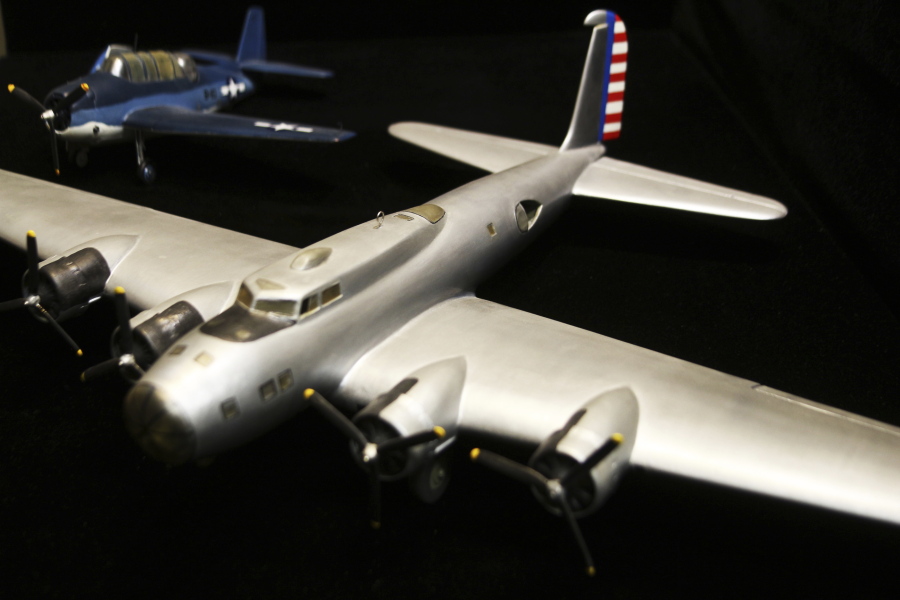KLAMATH FALLS, Ore. — Through a seemingly endless parade of books, movies, documentaries, archival footage and photographs, World War II and its impact still seem so accessible even though its origins began over 75 years ago.
Among the items on display at a new exhibit at the Klamath County Museum of one of the key battles of that war are handmade aircraft models, showing a unique and local perspective of life on the homefront during the war.
While Klamath County sent many of its young men and women off to war, the effort at home was dedicated as well. Timber mills and factories churned out wood products for the war effort at a frantic pace, and the rail lines steadily shipped materials to the front. Families grew victory gardens, bought war bonds, and kids collected scrap metal.
Among those young kids in Klamath Falls doing their part was Chuck Johnson, now 88, who vicariously connected with the epic air battles of the war by developing a passion for wooden World War II aircraft models.
In 1942, Johnson saw a peer with an aircraft model and bought it from him for a quarter. He soon found out that Wes Withrow, owner of a woodshop in the Mills Addition, had made it, and, along with other students, an after-school model-making club soon formed.
Using magazines and an Aeronautic Aircraft Spotters Guide for Civil Defense, kids ages 12-13 carved wood blocks leftover from local mills into intricate models of the fighters and bombers immersed in combat overseas.
Using pieces from orange crates and wood tailings blocks, Johnson would slowly shape remarkably detailed airplanes true to the real thing. Popsicle sticks were used for propellers, nails and pens added for guns. Plastic packaging of everyday products were shaped for cockpit canopies.
A local bicycle shop downtown provided other parts necessary to create miniaturized versions of the now iconic warbirds, though due to shortages from the warm Johnson and his friends had to often use their imagination to find the right piece to complete the model.
While many of Johnson’s peers eventually grew out of the hobby, he stuck with it through the war. By war’s end he had built 40 different war planes from single blocks of wood, from small single-engine aircraft to massive four-engine bombers like the Boeing B-17.
“Later on, during the war, there were things we couldn’t get because of the rationing, but we’d go to a bicycle shop downtown that had a lot of model parts in the scale we worked in,” explained Johnson.
“The rest of the work was all solid models carved out of tailings from the timber mills. It was fun making things, and it gave me something to do during my free time.”
As the war progressed and Johnson got into high school, he joined the war effort through the trades and industries program, allowing half his school day to be spent as a machinist apprentice. He earned $0.37 an hour for his labor at the Great Northern Railroad Depot, though, after two years, he received a massive boost in pay to a whopping $1.92 an hour.
Eventually, the models were relegated to the attic and largely forgotten. Johnson would go on to join the U.S. Army in an artillery battalion during the Korean War, though he never shipped out to participate in combat.
He flew often in airplanes during his time in the military and took a couple rides in small civilian aircraft, but never had an interest in acquiring his pilot’s license due to the expense.
It was 45 years later that Johnson’s childhood crafts were rediscovered, buried in the attic of his recently deceased mother’s home, still intact from his model-making days during World War II. They had suffered inevitable damage from curious dogs and excited children, but were still mostly intact.
After retiring in 1990, Johnson decided to restore the wood models to their former glory. After completion, many were displayed for a time at the Klamath County Museum by then museum manager Judith Hassen.
She traveled to Midway to research the important World War II-era battle that turned the tide of the Pacific Theater, and later moved to Washington D.C., but she never forgot about Johnson’s collection of vintage wooden models.
Recently the Klamath County Museum established an exhibit highlighting the Battle of Midway, and Hassen, having returned to Klamath County, reached out to Johnson to see if the World War II-era models were still intact. They were, in fact, all hanging from the ceiling of the guest bedroom in Johnson’s home, recreating an epic aerial battle from the war.
Johnson still possesses many of the vintage World War II-era publications he used to base his models on, including the old civil defense guidebook that inspired many of his original models.
“I picked up the hobby again,” said Johnson. “I got lucky that my mother saved them from when I was a kid.”
Several of Johnson’s aircraft now highlight the Midway display at the museum, Japanese and American aircraft encased alongside vintage newspapers and photos showcasing the importance of that battle.
More than just a representation of warbirds of yesteryear, the aircraft models are a physical relic showing how citizens on the homefront connected with the war effort, did their part for victory, and found ways to cope through shortages and rationing.



